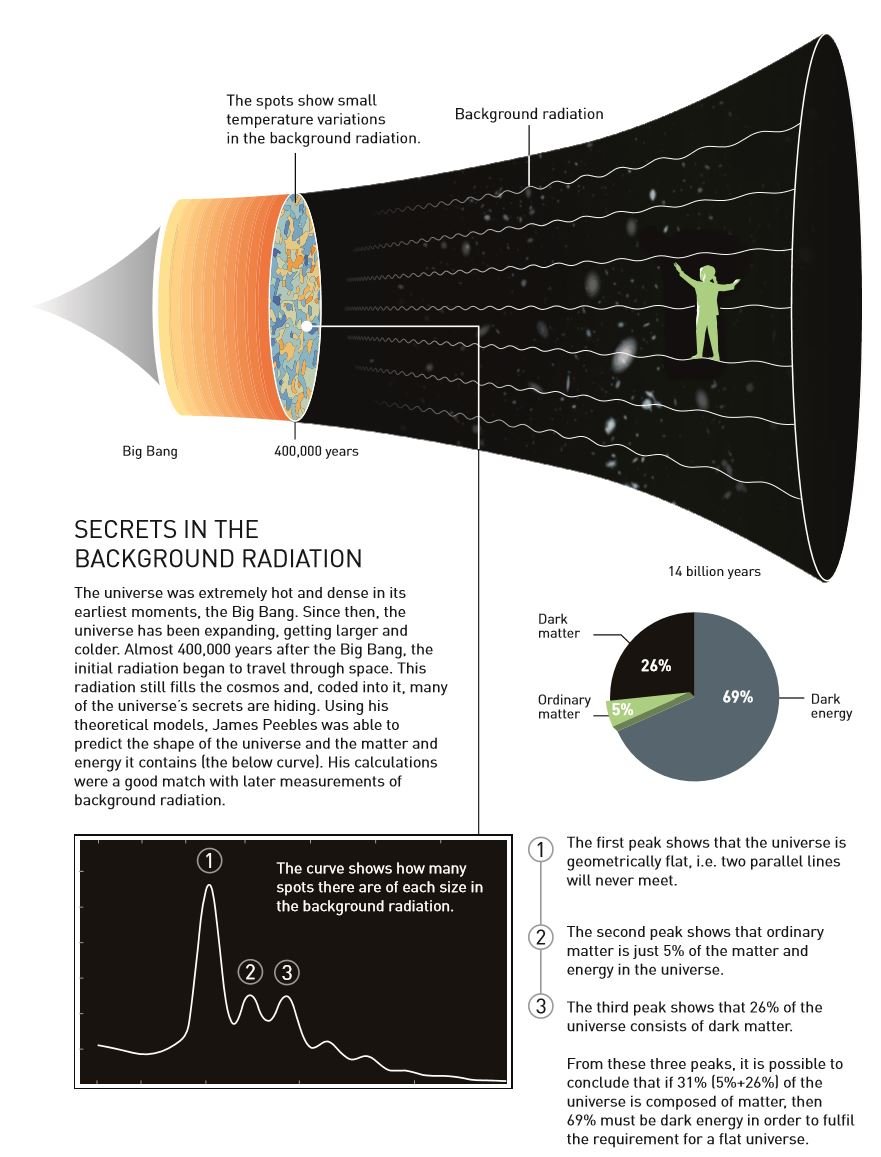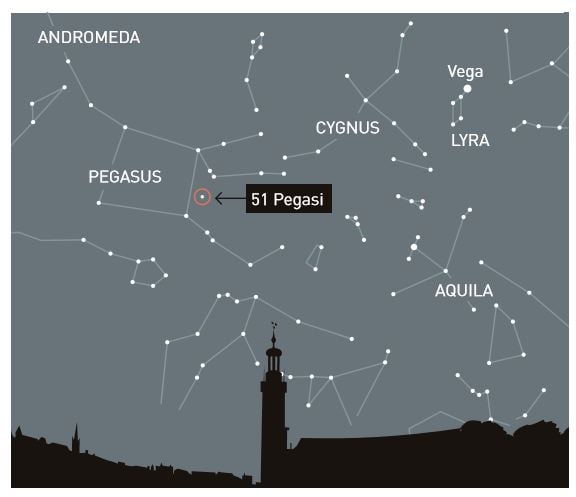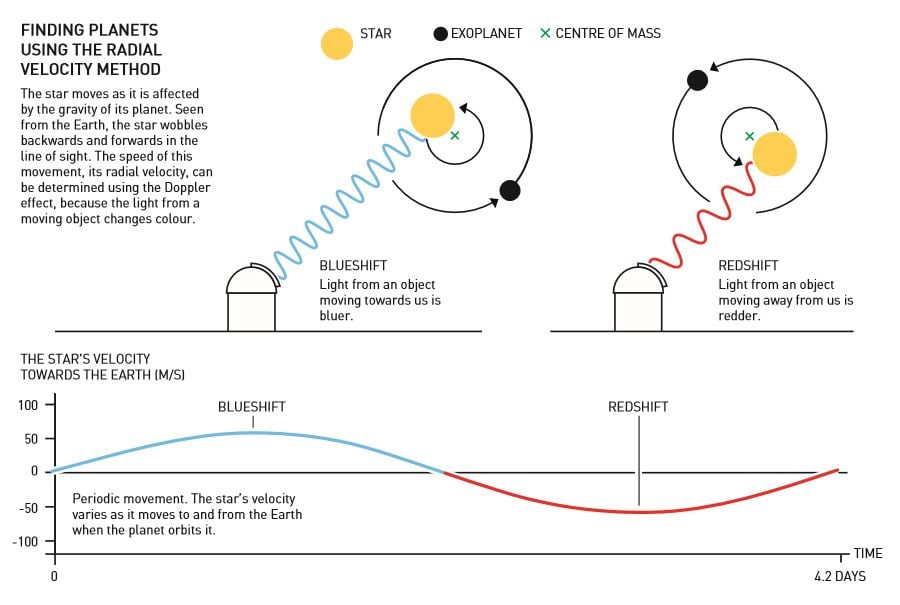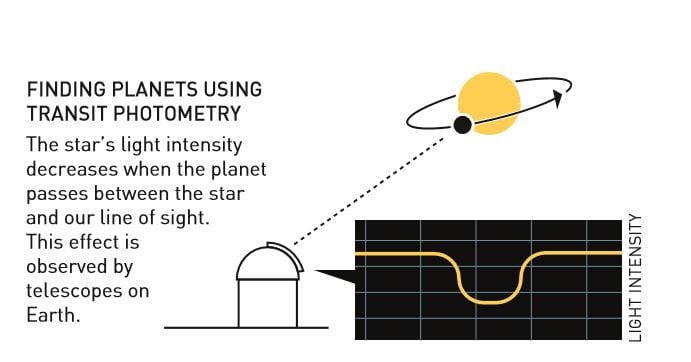Popular information
Popular science background:
New perspectives on our place in the universe (pdf)
Populärvetenskaplig information:
De gav oss ny syn på vår plats i universum (pdf)

The Nobel Prize in Physics 2019
The Nobel Prize in Physics 2019 rewards new understanding of the universe’s structure and history, and the first discovery of a planet orbiting a solar-type star outside our solar system. This year’s Laureates have contributed to answering fundamental questions about our existence. What happened in the early infancy of the universe and what happened next? Could there be other planets out there, orbiting other suns?
New perspectives on our place in the universe
James Peebles took on the cosmos, with its billions of galaxies and galaxy clusters. His theoretical framework, which he developed over two decades, starting in the mid-1960s, is the foundation of our modern understanding of the universe’s history, from the Big Bang to the present day. Peebles’ discoveries have led to insights about our cosmic surroundings, in which known matter comprises just five per cent of all the matter and energy contained in the universe. The remaining 95 per cent is hidden from us. This is a mystery and a challenge to modern physics.

Michel Mayor and Didier Queloz have explored our home galaxy, the Milky Way, looking for unknown worlds. In 1995, they made the very first discovery of a planet outside our solar system, an exoplanet, orbiting a solar-type star. Their discovery challenged our ideas about these strange worlds and led to a revolution in astronomy. The more than 4,000 known exoplanets are surprising in their richness of forms, as most of these planetary systems look nothing like our own, with the Sun and its planets. These discoveries have led researchers to develop new theories about the physical processes responsible for the birth of planets.
Big Bang cosmology begins
The last five decades have been a golden age for cosmology, the study of the universe’s origin and evolution. In the 1960s, a foundation was laid that would shift cosmology from speculation to science. The key person in this transition was James Peebles, whose decisive discoveries put cosmology firmly on the scientific map, enriching the entire field of research. His first book, Physical Cosmology (1971), inspired a whole new generation of physicists to contribute to the subject’s development, not only through theoretical considerations but with observations and measurements. Science and nothing else would answer the eternal questions about where we come from and where we are going; cosmology was freed from human concepts such as faith and meaning. This echoes Albert Einstein’s words from early last century, on how the mystery of the world is its comprehensibility.
The story of the universe, a scientific narrative of the evolution of the cosmos, has only been known for the last hundred years. Prior to this, the universe had been regarded as stationary and eternal, but in the 1920s astronomers discovered that all galaxies are moving away from each other and from us. The universe is growing. We now know that the universe of today is different to that of yesterday and that it will be different tomorrow.
What the astronomers saw in the heavens had already been predicted by Albert Einstein’s general theory of relativity from 1916, the one that is now the basis of all large scale calculations about the universe. When Einstein discovered that the theory led to the conclusion that the universe is collapsing, he added a constant to his equations (the cosmological constant) that would counterbalance the effects of gravity and make the universe stand still. Over a decade later, once the universe’s expansion had been observed, this constant was no longer necessary. Einstein regarded this as his life’s biggest blunder. Little did he know that the cosmological constant would make a magnificent return to cosmology in the 1980s, not least through the contributions of James Peebles.
The first rays of the universe reveal all
The universe’s expansion means that it was once much denser and hotter. In the mid-20th century, its birth was named the Big Bang. No one knows what actually happened at the very beginning, but the early universe was full of a compact, hot and opaque particle soup in which light particles, photons, just bounced around.
It took almost 400,000 years for expansion to cool this primordial soup to a few thousand degrees Celsius. The original particles were able to combine, forming a transparent gas that primarily consisted of hydrogen and helium atoms. Photons now began to move freely and light was able to travel through space. These first rays still fill the cosmos. The expansion of space stretched the visible light waves so they ended up in the range of invisible microwaves, with a wavelength of a few millimetres.
The glow from the birth of the universe was first captured by chance, in 1964, by two American radio astronomers: the 1978 Nobel Laureates Arno Penzias and Robert Wilson. They could not get rid of the constant “noise” that their antenna picked up from everywhere in space, so they looked for an explanation in the work of other researchers, including James Peebles, who had made theoretical calculations of this omnipresent background radiation. After almost 14 billion years, its temperature has dropped close to absolute zero (–273°C). The major breakthough came when Peebles realised that the radiation’s temperature could provide information about how much matter was created in the Big Bang, and understood that the release of this light played a decisive role in how matter could later clump up to form the galaxies and galaxy clusters that we now see in space.
The discovery of microwave radiation ushered in the new era of modern cosmology. The ancient radiation from the universe’s infancy has become a goldmine that contains the answers to almost everything cosmologists want to know. How old is the universe? What is its fate? How much matter and energy exist?
Scientists can find traces of the very first moments of the universe in this cold afterglow, tiny variations propagating as soundwaves through that early primordial soup. Without these small variations, the cosmos would have cooled from a hot ball of fire to a cold and uniform emptiness. We know that this did not happen, that space is full of galaxies, often gathered in galaxy clusters. The background radiation is smooth in the same way that the ocean’s surface is smooth; the waves are visible close up, ripples that reveal the variations in the early universe.
Time after time, James Peebles has led the interpretation of these fossil traces from the earliest epochs of the universe. With astounding accuracy, cosmologists were able to predict variations in the background radiation and show how they affect the matter and energy in the universe.
The first major observational breakthrough came in April 1992, when principal investigators at the American COBE satellite project presented an image of the first rays of light in the universe (Nobel Prize in Physics 2006 to John Mather and George Smoot). Other satellites, the American WMAP and European Planck, gradually refined this portrait of the young universe. Exactly as predicted, the background radiation’s otherwise even temperature varied by one hundred-thousandth of a degree. With increasing precision, the theoretical calculations of the matter and energy contained in the universe were confirmed, with the majority of it, 95 per cent, invisible to us.
Dark matter and dark energy – cosmology’s greatest mysteries
Since the 1930s, we have known that all we can see is not all there is. Measurements of galaxies’ rotational speeds indicated that they must be held together by gravity from invisible matter, otherwise they would be torn apart. It was also thought that this dark matter played an important role in the origin of galaxies, long before the primordial soup relaxed its hold on the photons.
The composition of dark matter remains one of cosmology’s greatest mysteries. Scientists long believed that already-known neutrinos could constitute this dark matter, but the unimaginable numbers of low-mass neutrinos that cross space at almost the speed of light are far too fast to help hold matter together. Instead, in 1982, Peebles proposed that heavy and slow particles of cold dark matter could do the job. We are still searching for these unknown particles of cold dark matter, which avoid interacting with already known matter and comprise 26 per cent of the cosmos.
According to Einstein’s general theory of relativity, the geometry of space is interconnected with gravity – the more mass and energy the universe contains, the more curved space becomes. At a critical value of mass and energy, the universe does not curve. This type of universe, in which two parallel lines will never cross, is usually called flat. Two other options are a universe with too little matter, which leads to an open universe in which parallel lines eventually diverge, or a closed universe with too much matter, in which parallel lines will ultimately cross.
Measurements of cosmic background radiation, as well as theoretical considerations, provided a clear answer – the universe is flat. However, the matter it contains is only enough for 31 per cent of the critical value, of which 5 per cent is ordinary matter and 26 per cent is dark matter. Most of it, 69 per cent, was missing. James Peebles once again provided a radical solution. In 1984, he contributed to reviving Einstein’s cosmological constant, which is the energy of empty space. This has been named dark energy and fills 69 per cent of the cosmos. Along with cold dark matter and ordinary matter, it is enough to support the idea of a flat universe.
Dark energy remained just a theory for 14 years, until the universe’s accelerating expansion was discovered in 1998 (Nobel Prize in Physics 2011 to Saul Perlmutter, Brian Schmidt and Adam Riess). Something other than matter must be responsible for the increasingly rapid expansion – an unknown dark energy is pushing it. Suddenly, this theoretical addendum became a reality that could be observed in the heavens.
Both dark matter and dark energy are now among the greatest mysteries in cosmology. They only make themselves known through the impact they have on their surroundings – one pulls, the other pushes. Otherwise, not much is known about them. What secrets are concealed in this dark side of the universe? What new physics is hidden behind the unknown? What else will we discover in our attempts to solve the mysteries of space?

The first planet orbiting another sun
Most cosmologists now agree that the Big Bang model is a true story about the origin and development of the cosmos, despite only five per cent of its matter and energy now being known. This tiny slice of matter eventually clumped together to make everything we see around us – stars, planets, trees and flowers, and humans too. Are we alone in gazing out on the cosmos? Is there life anywhere else in space, on a planet orbiting another sun? No one knows. But we now know that our Sun is not alone in having planets, and that most of the several hundred billion stars in the Milky Way should also have accompanying planets. Astronomers now know of more than 4,000 exoplanets. Strange new worlds have been discovered, nothing like our own planetary system. The first was so peculiar that almost no one believed it was true; the planet was too big to be so close to its host star.
Michel Mayor and Didier Queloz announced their sensational discovery at an astronomy conference in Florence, Italy, on 6 October 1995. It was the first planet proven to be orbiting a solar-type star. The planet, 51 Pegasi b, moves rapidly around its star, 51 Pegasi, which is 50 light years from the Earth. It takes four days to complete its orbit, which means that its path is close to the star – only eight million kilometres from it. The star heats the planet to more than 1,000°C. Things are considerably calmer on Earth, which has a year-long orbit around the Sun at a distance of 150 million kilometres.
The newly discovered planet also turned out to be surprisingly large – a gaseous ball that is comparable to the solar system’s biggest gas giant, Jupiter. Compared to the Earth, Jupiter’s volume is 1,300 times greater and it weighs 300 times as much. According to previous ideas about how planetary systems are formed, Jupiter-sized planets should have been created far from their host stars, and consequently take a long time to orbit them. Jupiter takes almost 12 years to complete one circuit of the Sun, so 51 Pegasi b’s short orbital period was a complete surprise to exoplanet hunters. They had been looking in the wrong place.
Almost immediately after this revelation, two American astronomers, Paul Butler and Geoffrey Marcy, turned their telescope towards the star 51 Pegasi and were soon able to confirm Mayor and Queloz’s revolutionary discovery. Just a few months later they found two new exoplanets orbiting solar-type stars. Their short orbital periods were handy for astronomers who did not need to wait months or years to see an exoplanet orbit its sun. Now they had time to watch the planets take one lap after another.

How had they got so close to the star? The question challenged the existing theory of planetary origins and led to new theories that described how large balls of gas were created at the edges of their solar systems, then spiralled inward towards the host star.
Refined methods led to the discovery
Sophisticated methods are necessary to track an exoplanet – planets do not glow by themselves, they simply reflect the starlight so weakly that their glow is smothered by the bright light of the host star. The method used by research groups to find a planet is called the radial velocity method; it measures the movement of the host star as it is affected by the gravity of its planet. As the planet orbits around its star, the star also moves slightly – they both move around their common centre of gravity. From the observation point on Earth, the star wobbles backwards and forwards in the line of sight.
The speed of this movement, the radial velocity, can be measured using the well-known Doppler effect – light rays from an object moving towards us are bluer and, if the object is moving away from us, the rays are redder. This is the same effect we hear when the sound of an ambulance increases in pitch as it moves towards us and decreases in pitch when the ambulance has passed.
The effect of the planet thus alternately changes the colour of the star’s light towards blue or red; it is these alterations in the wavelength of the light that astronomers capture with their instruments. The changes in colour can be precisely determined by measuring the star’s light wavelengths, providing a direct measure of its velocity in the line of sight.
The biggest challenge is that the radial velocities are extremely low. For example, Jupiter’s gravity makes the Sun move at about 12 m/s around the solar system’s centre of gravity. The Earth contributes just 0.09 m/s, which places extraordinary demands on the equipment’s sensitivity if Earth-like planets are to be discovered. To increase precision, astronomers measure several thousand wavelengths simultaneously. The light is divided into the various wavelengths using a spectrograph, which is at the heart of these measurements.

In the early 1990s, when Didier Queloz started his research career at the University of Geneva, Michel Mayor had already spent many years studying the movement of the stars, constructing his own measuring instruments with the help of other researchers. In 1977, Mayor was able to mount his very first spectrograph on a telescope at the Haute-Provence Observatory, 100 km northeast of Marseille. This allowed a lower limit of velocities around 300 m/s, but this was still too high to see a planet pulling on its star.
Along with the research group, doctoral student Didier Queloz was asked to develop new methods for more precise measurements. They utilised numerous new technologies that made it possible to look rapidly at many stars and analyse the results on site. Optical fibres could carry the starlight to the spectrograph without distorting it and better digital image sensors, CCDs, increased the machine’s light sensitivity (Nobel Prize in Physics 2009 to Charles Kao, Willard Boyle and George Smith). More powerful computers allowed scientists to develop custom-made software for digital image and data processing.
When the new spectrograph was finished in the spring of 1994, the necessary velocity sank to 10–15 m/s and the first discovery of an exoplanet was fast approaching. At that time, the search for exoplanets was not part of mainstream astronomy, but Mayor and Queloz had decided to announce their discovery. They spent several months refining their results and, in October 1995, they were ready to present their very first planet to the world.
A multitude of worlds is revealed
The first discovery of an exoplanet orbiting a solar-type star started a revolution in astronomy. Thousands of unknown new worlds have been revealed. New planetary systems are now not only being discovered by telescopes on Earth, but also from satellites. TESS, an American space telescope, is currently scanning more than 200,000 of the stars closest to us, hunting for Earth-like planets. Previously, the Kepler Space Telescope had brought rich rewards, finding more than 2,300 exoplanets.
Along with variations in radial velocity, transit photometry is now used when searching for exoplanets. This method measures changes in the intensity of the star’s light when a planet passes in front of it, if this happens in our line of sight. Transit photometry also allows astronomers to observe the exoplanet’s atmosphere as light from the star passes it on the way towards Earth. Sometimes both methods can be used; transit photometry provides the size of the exoplanet, while its mass can be determined using the radial velocity method. It is then possible to calculate the exoplanet’s density and thus determine its structure.

The exoplanets so far discovered have surprised us with an astounding variety of forms, sizes and orbits. They have challenged our preconceived ideas about planetary systems and forced researchers to revise their theories about the physical processes responsible for the birth of planets. With numerous projects planned to start searching for exoplanets, we may eventually find an answer to the eternal question of whether other life is out there.

The Sun is one of several hundred billion stars in our home galaxy, the Milky Way, and there should be planets orbiting most of those stars. So far, astronomers have discovered over 4,000 planets around other stars and they are continuing their search in the area of space closest to us.
This year’s Laureates have transformed our ideas about the cosmos. While James Peebles’ theoretical discoveries contributed to our understanding of how the universe evolved after the Big Bang, Michel Mayor and Didier Queloz explored our cosmic neighbourhoods on the hunt for unknown planets. Their discoveries have forever changed our conceptions of the world.
The Royal Swedish Academy of Sciences has decided to award the Nobel Prize in Physics 2019
“for contributions to our understanding of the evolution of the universe and Earth’s place in the cosmos”
with one half to
JAMES PEEBLES
Born 1935 in Winnipeg, Canada.
Ph.D. 1962 from Princeton University,
USA. Albert Einstein Professor of
Science at Princeton University, USA.
“for theoretical discoveries in physical cosmology”
and the other half jointly to
MICHEL MAYOR
Born 1942 in Lausanne, Switzerland.
Ph.D. 1971 from University of Geneva,
Switzerland. Professor at University of
Geneva, Switzerland.
and
DIDIER QUELOZ
Born 1966 in Geneva, Switzerland.
Ph.D. 1995 from University of
Geneva, Switzerland. Professor at
University of Geneva, Switzerland
and University of Cambridge, UK.
“for the discovery of an exoplanet orbiting a solar-type star”
Science Editors: Ulf Danielsson, Ariel Goobar, Gunnar Ingelman and Mats Larsson, the Nobel Committee for Physics
Text: Joanna Rose
Translation: Clare Barnes
Illustrations: © Johan Jarnestad/The Royal Swedish Academy of Sciences
Editor: Sara Gustavsson
© The Royal Swedish Academy of Sciences
Nobel Prizes and laureates
Six prizes were awarded for achievements that have conferred the greatest benefit to humankind. The 12 laureates' work and discoveries range from proteins' structures and machine learning to fighting for a world free of nuclear weapons.
See them all presented here.
